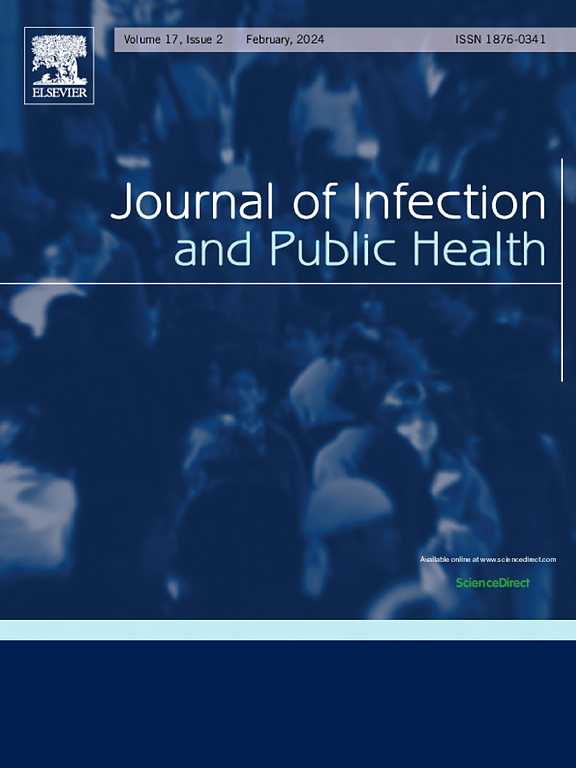病灶最大横截面积对预测耐多药结核病早期治疗反应的影响。
IF 4.7
3区 医学
Q1 INFECTIOUS DISEASES
引用次数: 0
摘要
背景:早期评估耐多药结核病(MDR-TB)治疗6个月后培养转化对预后预测至关重要。本研究旨在合并治疗期间通过计算机断层扫描(CT)成像观察到的最大病变横截面积,以预测治疗反应。方法:我们回顾性研究了来自两家医院完成6个月治疗的耐多药结核病患者。根据痰培养结果将患者分为培养对话组和无培养对话组。两家医院的数据分别用作内部培训队列和外部测试队列。利用最大病变横截面积和最重要的预测特征建立了逻辑回归和随机森林模型。使用曲线下面积(AUC)、准确性、敏感性、特异性和F1评分来评估模型的性能。结果:在不考虑最大病变截面积预测耐多药结核治疗6个月后培养转化的模型中,logistic回归和随机森林模型的AUC值分别为0.796和0.958,灵敏度分别为0.725和0.993,训练队列F1评分分别为0.803和0.957。在检验队列中,logistic回归和随机森林模型的AUC值分别为0.889和0.855。在训练队列中,logistic回归和随机森林模型评估基线、2个月和6个月时的最大病变横截面积,AUC值为0.819和0.998,灵敏度为0.674和1.000,F1评分为0.772和0.986。在检测队列中,AUC值分别为0.869和0.920,敏感性分别为0.933和1.000,F1评分分别为0.848和0.841。结论:在治疗过程中整合最大病变横截面积可以提高对耐多药结核病早期治疗反应的预测。当应用于临床环境时,随机森林模型更适合于快速指导合适的治疗方案。本文章由计算机程序翻译,如有差异,请以英文原文为准。
The impact of maximum cross-sectional area of lesion on predicting the early therapeutic response of multidrug-resistant tuberculosis
Background
Early evaluation of culture conversion after 6-month treatment of multidrug-resistant tuberculosis (MDR-TB) is vital for outcome prediction. This study aims to merge the maximum lesion cross-sectional area observed via computed tomography (CT) imaging during treatment to predict therapeutic response.
Methods
We retrospectively involved MDR-TB patients who completed 6 months of treatment from two hospitals. Patients were categorized into culture conversation and no culture conversation groups based on sputum culture results. The data from the two hospitals were used as internal training and external testing cohorts, respectively. Logistic regression and random forest models were developed using the maximum lesion cross-sectional area and most important predictive features. The model performance was evaluated using the area under the curve (AUC), accuracy, sensitivity, specificity, and F1 score.
Results
In the model without the maximum lesion cross-sectional area to predict culture conversion for MDR-TB after 6 months of treatment, logistic regression and random forest models achieved AUC values of 0.796 and 0.958, sensitivities of 0.725 and 0.993, and F1 scores of 0.803 and 0.957 in the training cohort, respectively. In the testing cohort, logistic regression and random forest models achieved AUC values of 0.889 and 0.855, respectively. Evaluating the maximum lesion cross-sectional area at baseline, 2 months, and 6 months, logistic regression and random forest models in the training cohort yielded AUC values of 0.819 and 0.998, sensitivities of 0.674 and 1.000, and F1 scores of 0.772 and 0.986. In the testing cohort, the AUC values were 0.869 and 0.920, sensitivities were 0.933 and 1.000, and F1 scores were 0.848 and 0.841, respectively.
Conclusions
The integration of maximum lesion cross-sectional area during treatment can improve the prediction of early treatment response in MDR-TB. When applied in a clinical setting, the random forest model is more suitable for guiding appropriate treatment plans quickly.
求助全文
通过发布文献求助,成功后即可免费获取论文全文。
去求助
来源期刊

Journal of Infection and Public Health
PUBLIC, ENVIRONMENTAL & OCCUPATIONAL HEALTH -INFECTIOUS DISEASES
CiteScore
13.10
自引率
1.50%
发文量
203
审稿时长
96 days
期刊介绍:
The Journal of Infection and Public Health, first official journal of the Saudi Arabian Ministry of National Guard Health Affairs, King Saud Bin Abdulaziz University for Health Sciences and the Saudi Association for Public Health, aims to be the foremost scientific, peer-reviewed journal encompassing infection prevention and control, microbiology, infectious diseases, public health and the application of healthcare epidemiology to the evaluation of health outcomes. The point of view of the journal is that infection and public health are closely intertwined and that advances in one area will have positive consequences on the other.
The journal will be useful to all health professionals who are partners in the management of patients with communicable diseases, keeping them up to date. The journal is proud to have an international and diverse editorial board that will assist and facilitate the publication of articles that reflect a global view on infection control and public health, as well as emphasizing our focus on supporting the needs of public health practitioners.
It is our aim to improve healthcare by reducing risk of infection and related adverse outcomes by critical review, selection, and dissemination of new and relevant information in the field of infection control, public health and infectious diseases in all healthcare settings and the community.
 求助内容:
求助内容: 应助结果提醒方式:
应助结果提醒方式:


